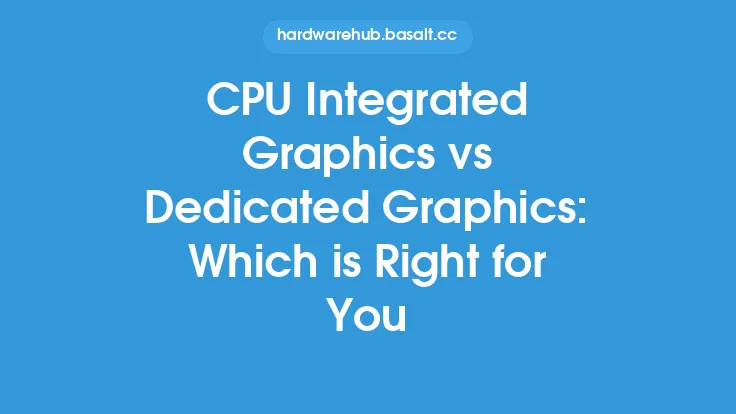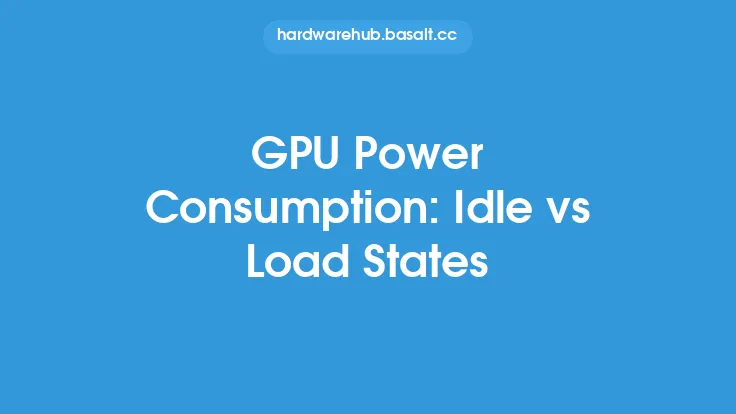When it comes to computer hardware, one of the most critical components is the Graphics Processing Unit (GPU). The GPU is responsible for rendering images on a computer screen and is a crucial component for gaming, video editing, and other graphics-intensive tasks. There are two primary types of GPUs: integrated and dedicated. Integrated GPUs are built into the computer's processor, while dedicated GPUs are separate cards that are installed in the computer's motherboard. One of the key differences between these two types of GPUs is their power consumption.
Introduction to Integrated GPUs
Integrated GPUs, also known as shared graphics or integrated graphics processing units (iGPUs), are built into the computer's processor. They use the computer's system memory (RAM) for graphics processing, which can lead to slower performance compared to dedicated GPUs. Integrated GPUs are commonly found in laptops, tablets, and low-end desktop computers. They are designed to provide basic graphics capabilities, such as displaying images and videos, and are not suitable for demanding tasks like gaming or video editing. Integrated GPUs typically consume less power than dedicated GPUs, with an average power consumption of around 15-30 watts.
Introduction to Dedicated GPUs
Dedicated GPUs, on the other hand, are separate cards that are installed in the computer's motherboard. They have their own dedicated memory (VRAM) and are designed to handle demanding graphics tasks like gaming, video editing, and 3D modeling. Dedicated GPUs are commonly found in gaming computers, workstations, and high-end desktop computers. They offer significantly better performance than integrated GPUs but consume more power. The power consumption of dedicated GPUs can range from around 60 watts to over 300 watts, depending on the model and manufacturer.
Power Consumption Comparison
The power consumption of integrated and dedicated GPUs can vary greatly, depending on the specific model and usage. Integrated GPUs typically consume less power than dedicated GPUs, but they also offer lower performance. Dedicated GPUs, on the other hand, offer better performance but consume more power. The power consumption of a GPU can be affected by several factors, including the clock speed, memory bandwidth, and manufacturing process. Generally, higher-end GPUs with faster clock speeds and more memory bandwidth consume more power than lower-end GPUs.
Factors Affecting Power Consumption
Several factors can affect the power consumption of a GPU, including the type of memory used, the manufacturing process, and the clock speed. GPUs with faster clock speeds and more memory bandwidth tend to consume more power than those with slower clock speeds and less memory bandwidth. Additionally, the type of memory used can also affect power consumption. For example, GPUs with GDDR6 memory tend to consume more power than those with GDDR5 memory. The manufacturing process can also play a role in power consumption, with GPUs manufactured using newer processes tend to consume less power than those manufactured using older processes.
Real-World Power Consumption Examples
To give you a better idea of the power consumption of integrated and dedicated GPUs, let's look at some real-world examples. The Intel Iris Xe, a high-end integrated GPU, consumes around 15-20 watts of power. In contrast, the NVIDIA GeForce RTX 3080, a high-end dedicated GPU, consumes around 260-320 watts of power. The AMD Radeon RX 6800 XT, another high-end dedicated GPU, consumes around 260-300 watts of power. These examples illustrate the significant difference in power consumption between integrated and dedicated GPUs.
Conclusion
In conclusion, the power consumption of integrated and dedicated GPUs can vary greatly, depending on the specific model and usage. Integrated GPUs typically consume less power than dedicated GPUs but offer lower performance. Dedicated GPUs, on the other hand, offer better performance but consume more power. Understanding the power consumption of GPUs is essential for building energy-efficient systems and reducing electricity bills. By choosing the right GPU for your needs, you can balance performance and power consumption to create a system that meets your requirements while minimizing its environmental impact.





